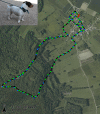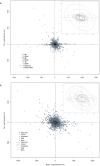Performance and Accuracy of Lightweight and Low-Cost GPS Data Loggers According to Antenna Positions, Fix Intervals, Habitats and Animal Movements
- PMID: 26086958
- PMCID: PMC4472960
- DOI: 10.1371/journal.pone.0129271
Performance and Accuracy of Lightweight and Low-Cost GPS Data Loggers According to Antenna Positions, Fix Intervals, Habitats and Animal Movements
Abstract
Recently developed low-cost Global Positioning System (GPS) data loggers are promising tools for wildlife research because of their affordability for low-budget projects and ability to simultaneously track a greater number of individuals compared with expensive built-in wildlife GPS. However, the reliability of these devices must be carefully examined because they were not developed to track wildlife. This study aimed to assess the performance and accuracy of commercially available GPS data loggers for the first time using the same methods applied to test built-in wildlife GPS. The effects of antenna position, fix interval and habitat on the fix-success rate (FSR) and location error (LE) of CatLog data loggers were investigated in stationary tests, whereas the effects of animal movements on these errors were investigated in motion tests. The units operated well and presented consistent performance and accuracy over time in stationary tests, and the FSR was good for all antenna positions and fix intervals. However, the LE was affected by the GPS antenna and fix interval. Furthermore, completely or partially obstructed habitats reduced the FSR by up to 80% in households and increased the LE. Movement across habitats had no effect on the FSR, whereas forest habitat influenced the LE. Finally, the mean FSR (0.90 ± 0.26) and LE (15.4 ± 10.1 m) values from low-cost GPS data loggers were comparable to those of built-in wildlife GPS collars (71.6% of fixes with LE < 10 m for motion tests), thus confirming their suitability for use in wildlife studies.
Conflict of interest statement
Figures


References
-
- Coelho CM, de Melo LFB, Sábato MAL, Rizel DN, Young RJ. A note on the use of GPS collars to monitor wild maned wolves Chrysocyon brachyurus (Illiger 1815) (Mammalia, Canidae). Applied Animal Behaviour Science 2007; 105: 259–264. Available: 10.1016/j.applanim.2006.04.024. - DOI
-
- Frair JL, Nielsen SE, Merrill EH, Lele SR, Boyce MS, Munro RHM, et al. Removing GPS collar bias in habitat selection studies. Journal of Applied Ecology 2004; 41: 201–212. 10.1111/j.0021-8901.2004.00902.x - DOI
-
- Soutullo A, Cadahia L, Urios V, Ferrer M, Negro JJ. Accuracy of Lightweight Satellite Telemetry: A Case Study in the Iberian Peninsula. The Journal of Wildlife Management 2007; 71: 1010–1015. 10.2193/2006-042 - DOI
Publication types
MeSH terms
Associated data
LinkOut - more resources
Full Text Sources
Other Literature Sources

